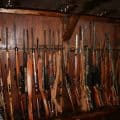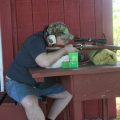So What Now?
Since the announcement in of Indiana’s rule changes allowing centerfire rifle for deer, I have been deluged. The same was true earlier in the year when Ohio announced PCR for deer. Everyone wants to know what it all really means. My guess is it means y’all are going to be wanting some new deer rifles.
The big thing to remember in both cases is that the average deer is taken inside 80 yards. If you hunt out of a stand in the woods, that distance will be shorter still. Hunting in Kentucky for 15 years, I think my longest shot was 175 yards. Some have been 5 yards. Most have been inside 50.
Let me discuss Ohio’s situation first. Hoosiers can skip down the page. I won’t mind.
OHIO
Proposed hunting rifles are chambered for the following calibers: .357 Magnum, .357 Maximum, .38 Special, .375 Super Magnum, .375 Winchester, .38-55, .41 Long Colt, .41 Magnum, .44 Special, .44 Magnum, .444 Marlin, .45 ACP, .45 Colt, .45 Long Colt, .45 Winchester Magnum, .45 Smith & Wesson, .454 Casull, .460 Smith & Wesson, .45-70, .45-90, .45-110, .475 Linebaugh, .50-70, .50-90, .50-100, .50-110 and .500 Smith & Wesson.
This is not the list I would have made, but there it is. The general nudge here is to get you into a single-shot rifle. That is the only kind of rifle a lot of these are chambered for. If you are into a break-action single-shot, there are a lot of choices. There are darn few bolt-actions made in any of these choices, and a minority of lever actions. Of the lot, a few catch my eye, simply because I know there decent rifles out there made for them. If you could find a .375 Winchester, I think that would be the best of the lot. 45-70? It’s great. However, you need to qualify that. There are 45-70 loads that are up with the 458 Win Mag. There are 45-70 loads that can not a whole lot harder on the shoulder than a 44 Mag. If you know 45-70, then you know what I mean. If you are unfamiliar, research this carefully, especially if you are going to be buying factory ammo. 444 Marlin is a good deer stopper. 44 Magnum and 45 Cold do about the same as a 30-30 WIN out to about 80 yards and then start to drops off.
In general, the choices presented are meant to be no better or worse than what you already have on the shelf. 357 Magnum is good out to about 50 yards. Of what is on the list, that would be about my bottom end. That knocks off .38 Special and .45 ACP, unless you are doing this at bowhunter ranges. By the time you get to the top end, you have these big bullets getting lobbed through the air in trajectories that any shotgun hunter would recognize.
My recommendations? I like deer rifles with magazines. The easiest to find are going to be .44 Mag levers. A Ruger semi-auto would be great, but they stopped making them. A lever gun in .375 Winchester would be my ideal gun of the lot, but they stopped making those years ago as well. Any of the big-bore rifles will knock you sideways with factory ammo. If there ever was a reason to try reloading, this is it.
INDIANA
The sky’s the limit now. The shackles are off. What now? My answer is to take the middle road. What is the middle, you ask? If you look back in this weblog, I have frequently postulated that it is .300 Savage. Mind you, I don’t own one, but if you look at the specs for a .300 Savage, you have what I think is the ideal deer cartridge for the average deer hunter shooting the average deer in the average situation. If you do not like that choice, then fine. 7mm-08 is another one there in the middle. I do not mind. The point is that when you start looking at deer chamberings, give yourself an anchor point. There are going to be trade offs.
Recoil is going to be a big issue for you, more than anything else. If you are used to a 12 GA slug load, the recoil of a 30-06 is going to be about half that, and that is what most people think of as the comfortable dividing line. Here’s a recoil table. Draw a line at 30-06 165 grain load. I cannot see anyone going after whitetails in Indiana needing to punish their shoulders any more than that. Having said that, I own a 35 Whelen Remington 7600. I have shot more deer with that rifle than any other over the past decade. I am also the first to tell you that it is overkill. Compare the recoil of the benchmark 30-06 to the 35 Whelen 200 grain and then go back and look at that .300 Savage load I mentioned. See the differences?
I like 30 cal for deer. I started with a 30-06, and I have shot deer with a bunch of 30-something chamberings. For deer in the woods, I like taking a 308 WIN, downloading it to .300 Savage levels and go for it. When I am covering a pasture with a 200 yard shot possible, I like a 30-06 with 165 grain bullets. I own a 30-30, but I do not hunt with it much. I found 30-30 WIN to be anemic.
So what is wrong with 7mm? 270? 25? Nothing. In fact, I acquired a 25-06 recently and shot a deer with it this season. It died just like it had been hit with 30-06. For the most part anything that is legal in Indiana, when shot properly will make a deer go down just like a 30-06. .243 WIN? 300 Winchester Magnum? 270 Winchester? 375 H&H? They all pretty much do the same thing to a deer. Most of the differences get wasted in the dirt on the far side of the animal. As I said earlier, I have a 35 Whelen– the Whelenizer. Whelenizing deer really does not do anything more to the deer, but I just happen to like the cartridge. It makes a lot more noise. It thumps my shoulder a good deal, and the deer lay down and die. Sometimes they run a bit, but no more so than with anything else.
What about 8mm? 44 cal? That is fine. I’m currently working on a 8X57 Mauser project. The thing about caliber is this: the wider the bullet, the more air it has to push out of the way. I love my 35 caliber Whelenizer, but I would be the first to tell you that it thumps me a good one when I launch it. By the time you get to a .44 or .45 cal, you have a lot of energy spent to send a bullet in a very noticeable arc at your quarry.
What rifle? What action? I like rifles with magazines. Bolts? Levers? Pumps? I love them all. Semi-autos can be a bit of a hassle, but I dearly loved mine until I traded for a pump. Now I love my pump. I have bad eyes so all my deer guns have scopes. Magazines are a good idea for me. I always try and stay ready for a follow-on shot. I seldom need it. Is one action better than another? I prefer a bolt when I am in a blind, a lever when I am in a treestand and a pump or semi when I am on the ground. I could give you all kinds of reasons, but it boils down to taste. Truth is, one is as good as the other.
Here are some mental holes you need to keep from digging for yourself.
I’ll buy the big magnum and then shoot reduced recoil loads : Don’t. At least do not do it if you do not intend on reloading and you are contemplating those factory “Reduced Recoil” loads. Anything with “magnum” in its name is probably overkill on whitetails. Buy a rifle that truly suits your needs. I say that, because centerfire rifles can be touchy, and not every rifle is going to shoot those reduced factory loads well. If you are reloading, then by all means buy a 300 Magnum and run it at 30-06 levels. However, if you are not a handloader, buy the 270 WIN and not the 7 mm Rem Mag. The deer are going to be just as dead.
I want a rifle that shoots flat out to 500 yards. No you don’t. You have been reading too many magazines and the magazines glorify long shots on tiny fly-spec animals seen through a spotting scope. Sight in at 100 yards, practice out to 200 yards and be ready for something showing up inside 80 yards. Most people do not have the time to be practicing 500 yard shooting. If you do, then you probably so far beyond me, that you are not reading this article. I do as little as I can at the shooting bench and spend the time I save scouting in the woods.
I want the extra energy in case my shot is a little off: STOP. There is nothing, repeat nothing, that will offset a bad shot. Premium bullets will not. Magnum chamberings will not. Your goal is to hit an area about the size of a soccer ball in the middle of the deer’s chest. If you cannot do that, do not shoot.
I want Dead-Right-There power: Dead-Right-There (DRT) aka “BANG-FLOP” will happen. It is independent of what you use to hit the deer. I know fellows who have bang-flopped a deer with 223 REM. I’ve done it with .54 caliber lead ball from my Hawken. Same rifle, same load, same everything– some deer run, some fall over. It is as simple as that. If you take out both lungs and the heart, you can be assured that the deer will be able to stand in the deer’s tracks and see the carcass. If you only take out one lung, expect quite a bit of tracking. No change in rifle will change that outcome.
I want a good blood trail: No you do not. You want zero blood trail and the deer dead in its tracks. That has everything to do with good shot placement. A good blood trail comes from two things: angle and proper bullet performance. If you have and entrance wound and and exit wound that are high in the chest, the deer will go some distance before leaving a blood trail. If the exit wound is low, the blood will empty out of the chest sooner and quicker. The ability of a bullet to expand well at the distance you shoot will determine the size of the exit wound. I try to take out both lungs and the top of the heart. From there, it is up to God.
This post has already been read 460 times!
Views: 4






Comments
So What Now? — No Comments
HTML tags allowed in your comment: <a href="" title=""> <abbr title=""> <acronym title=""> <b> <blockquote cite=""> <cite> <code> <del datetime=""> <em> <i> <q cite=""> <s> <strike> <strong>